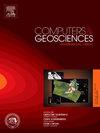A gradient-optimized least-squares reverse time migration based on the safe type-I anderson acceleration
IF 4.4
2区 地球科学
Q1 COMPUTER SCIENCE, INTERDISCIPLINARY APPLICATIONS
引用次数: 0
Abstract
Least-squares reverse time migration (LSRTM) can generate preferable images for complex media, but faces substantial computational challenges in field data applications, especially in 3D cases. Many optimization algorithms have been proposed to alleviate this problem, such as the limited-memory Broyden-Fletcher-Goldfarb-Shanno (LBFGS) method, the restarted generalized minimal residual method, and Anderson acceleration (AA). AA is a popular gradient optimization algorithm that has been widely used in many fields due to its ability to greatly accelerate the convergence of fixed-point iterations and considerably reduce the computational cost. According to Broyden's method, AA is divided into type-I AA (AA-I) and type-II AA (AA-II), with most implementations favoring AA-II due to residual oscillation issues observed in AA-I during data residual minimization. To address the residual vibration issue of AA-I and expedite the convergence of LSRTM, we apply a safe AA-I method to LSRTM, incorporating Powell-type regularization, re-start checking, and safe guarding steps. The Powell-type regularization guarantees the non-singularity of AA-I, while the re-start checking preserves its strong linear independence, both contributing to the stability of AA-I. The safe guarding steps examine the data residual reduction and accelerate the convergence. Our analysis reveals that the optimal step length for the safe AA-I method is approximately 5 times or 10 times the initial steepest descent (SD) iteration. We also derive an exponential scaling law for the safe AA-I step length. In addition, the safe AA-I has faster data residual convergence speed, less computational cost, and higher quality images than SD, conjugate gradient (CG), AA-II, and LBFGS. The safe AA-I is approximately twice as efficient as the LBFGS. Field validation through land seismic data processing shows that LSRTM based on the safe AA-I delivers enhanced structural resolution with sharper imaging events and improved stratigraphic continuity relative to LBFGS-based implementations.
基于安全i型安德森加速度的梯度优化最小二乘逆时偏移
最小二乘逆时偏移(LSRTM)可以为复杂介质生成更好的图像,但在现场数据应用中面临着巨大的计算挑战,特别是在3D情况下。为了解决这一问题,人们提出了许多优化算法,如有限记忆Broyden-Fletcher-Goldfarb-Shanno (LBFGS)法、重新启动广义最小残差法和Anderson加速(AA)法。AA是一种流行的梯度优化算法,由于其能够大大加快不动点迭代的收敛速度,大大降低计算成本,在许多领域得到了广泛的应用。根据Broyden的方法,AA分为i型AA (AA- i)和ii型AA (AA- ii),由于AA- i在数据残差最小化过程中观察到残差振荡问题,大多数实现倾向于AA- ii。为了解决AA-I的残余振动问题,加快LSRTM的收敛速度,我们将一种安全的AA-I方法应用于LSRTM,包括鲍威尔式正则化、重新启动检查和安全防护步骤。powell型正则化保证了AA-I的非奇异性,而重新启动检验保持了AA-I的强线性无关性,都有助于AA-I的稳定性。安全防护步骤检查数据残差减少,加快收敛速度。我们的分析表明,安全的AA-I方法的最佳步长大约是初始最陡下降(SD)迭代的5倍或10倍。我们还推导了安全AA-I步长的指数标度定律。此外,与SD、共轭梯度(CG)、AA-II和LBFGS相比,安全的AA-I具有更快的数据残差收敛速度、更少的计算成本和更高的图像质量。安全的AA-I的效率大约是LBFGS的两倍。通过陆地地震数据处理的现场验证表明,与基于lbfgs的方法相比,基于安全AA-I的LSRTM可以提高构造分辨率,成像事件更清晰,地层连续性更好。
本文章由计算机程序翻译,如有差异,请以英文原文为准。
求助全文
约1分钟内获得全文
求助全文
来源期刊

Computers & Geosciences
地学-地球科学综合
CiteScore
9.30
自引率
6.80%
发文量
164
审稿时长
3.4 months
期刊介绍:
Computers & Geosciences publishes high impact, original research at the interface between Computer Sciences and Geosciences. Publications should apply modern computer science paradigms, whether computational or informatics-based, to address problems in the geosciences.
 求助内容:
求助内容: 应助结果提醒方式:
应助结果提醒方式:


